Leaving Middle Tennessee for the Gulf Coast of Texas meant leaving behind four seasons, beautiful hilly terrain, and my house. I’ll miss all of that. What I won’t miss are the vultures that roosted in the trees behind the house.
Close Encounter
The first vultures on my property appeared over a decade ago. Only a few at first, then their numbers increased. (One day I counted more than seventy!) The numbers rose and fell over the years. There were even times when no vultures were there, but those times didn’t last long.
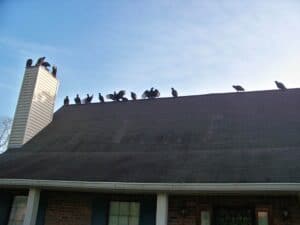
“The Birds”
One winter I was sitting in my upstairs office when I heard sounds coming from the attic. I thought squirrels had gotten in, but when I checked, I neither heard nor saw any sign of them. When I heard the sounds again, I went outside to see if there was something on the roof. There was. When I looked up, I felt like I’d stepped into a colorized version of Alfred Hitchcock’s 1963 movie, The Birds. Against a brilliant blue sky, almost two dozen Black Vultures perched on the roof’s peak, soaking up the morning sun. I took a few photos that first time—after recovering from the shock of finding every one of their beady eyes on me—then chased them away. From that point on, especially on cold but sunny winter days, I often had to chase them off the roof and/or my deck.
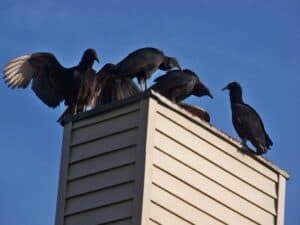
“Move over. You’re in my way.”
Vultures
Vultures are interesting creatures. They perform a vital role in cleaning up the environment by eating dead animals and reducing the spread of disease. Their stomach acid is exceptionally corrosive. Because of this, they can safely digest carcasses that other scavengers would find lethal.
There are sixteen species of Old World Vultures found in Europe, Africa, and Asia. The Americas and the Caribbean are home to seven species of New World Vultures. Only the continents of Australia and Antarctica don’t have at least one type of vulture.
New World Vultures have bald heads, and sharp, hooked beaks, but relatively weak legs and feet. Though red-headed Turkey Vultures outnumber Black Vultures in the U.S., there were only a few Turkey Vultures roosting in the trees behind my house. Most of “my” vultures were Blacks. They use the Turkey Vulture’s strong sense of smell to help locate meals. The Blacks’ excellent eyesight enables them to soar high while watching the low-flying Turkey Vultures. When a Turkey Vulture locates a carcass, the Blacks aren’t far behind.
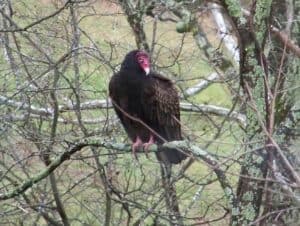
Turkey Vulture in the backyard.
New World Vultures: Did You Know…
- Vultures can live 20-30 years. It’s illegal to kill, shoot, or harm Black and Turkey Vultures in the U.S. Both are federally protected.
- All New World Vultures lack a voice box. Hissing, grunting, and bill clacking are the only sounds they make.
- Most vultures’ wingspan is four to six feet. The South American Andean Condor has a wingspan of ten to eleven feet, making it the largest in the world.
- A vulture can fly at speeds up to thirty miles per hour.
- To kill bacteria received from walking through carcasses, as well as to cool down, vultures urinate straight down their legs.
- Many vultures are monogamous and return to the same partner every breeding season.
- A Turkey Vulture can smell a carcass over a mile away.
- Because natural gas contains the same chemical found in a dead animal, gas leaks attract Turkey Vultures. These living, flying gas leak detectors have helped natural gas companies detect leaks.
- Some scientists are considering using vultures to find the bodies of people killed in a criminal act.
- Vultures often vomit when threatened. Not as a defense mechanism, though it may distract their attacker, but because emptying their stomach and lessening their body weight, makes take off and escape easier.
Final Thoughts
Vultures aren’t cute or majestic. To be honest, they’re only good for one thing, helping keep the environment clean. That’s a critical, if dirty job, but as the saying goes, someone’s got to do it. Still, while I appreciate vultures, I’m thankful I no longer have to deal with them.
Did You Know…
- A kettle is a group of vultures in flight. A group on the ground or in trees is a committee, venue, or volt. And a group feeding is called a wake.
- In Africa and Asia, poachers will poison elephant carcasses after removing the tusks. The idea is to kill the feeding vultures thus hiding the scene of the crime.
- One of the oldest musical instruments ever found is a flute made with a vulture’s 40,000-year-old wing bone.
- Rüppell’s Griffon Vulture, an Old World Vulture, is the world’s highest-flying bird. It’s been seen as high as 35,000 feet!
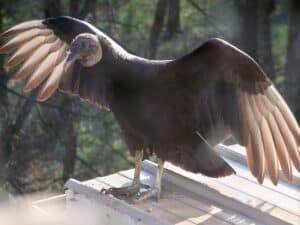
“Ahh, sun.”
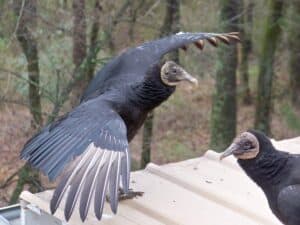
“Give me your honest opinion. Which side is my best?”

